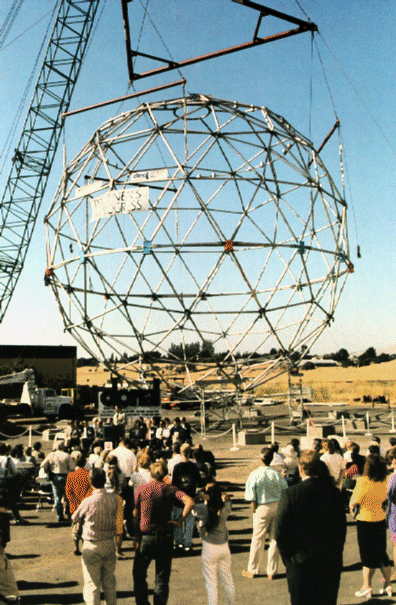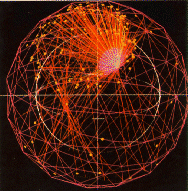
Designed by LBL's Nuclear Science and Engineering Divisions and assembled at Donal Machine, Incorporated, the 58,000 pound sphere will serve as the supporting frame for 10,000 photomultiplier tubes. These tubes are the heart of the SNO experiment.
SNO is a collaboration involving more than 60 scientists from LBL and 10 other laboratories and universities in the United States, Canada, and the United Kingdom. Its purpose is to answer some of the most perplexing questions about neutrinos, the ghost-like particles emitted from the sun and exploding stars, which could hold the key to the future of our universe.
Scientists think the universe began some 10 billion years ago with the Big Bang. Created in that explosion were neutrinos and every other type of particle that has ever existed. According to calculations, if neutrinos have sufficient mass, the universe will stop its current expansion and eventually collapse. SNO should tell scientists whether neutrinos have such a mass.
Another question to be answered by SNO is the mystery of solar neutrinos -- why do experiments record fewer solar neutrinos reaching the earth than theory predicts? This discrepancy casts doubts on our understanding of the nuclear reactions occurring in the sun, and on the Standard Model, the basic theory of particles and forces now invoked to explain virtually all the phenomena of modern physics.
The geodesic sphere has been shipped to the town of Sudbury, Canada, for reassembly some 6,800 feet underground in a cavern as large as a ten-story building. The sphere and the photomultiplier tubes connected to it will be suspended in the cavern, which will then be filled with 7,800 metric tons of ultraclean ordinary water. Suspended inside the sphere itself will be a plastic tank filled with the target material, 1,000 metric tons of heavy water (deuterium oxide).
When SNO begins operating, flashes of light known as Cerenkov radiation will be produced when neutrinos interact with deuterium nuclei or electrons. Through the detection of these flashes with the photomultiplier tubes, scientists will be able to count the three different types of neutrinos and compare the various interactions between neutrinos and the electrons and deuterium nuclei contained in the target. The SNO experiment will last at least 10 years and is expected to record between 10 to 20 neutrinos each day.
